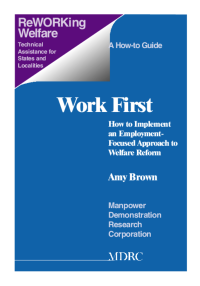Work First
How to Implement an Employment-Focused Approach to Welfare Reform
The first in MDRC's ReWORKing Welfare series of how-to guides, this volume is being published at a major turning point in welfare policy. The Personal Responsibility and Work Opportunity Reconciliation Act of 1996 has replaced the entitlement to Aid to Families with Dependent Children, and many states have already taken steps to redesign their welfare-to-work programs. One of the most popular program strategies, called "work first," aims to move participants into unsubsidized employment as quickly as possible through job search and short-term education, training, or work experience activities. Programs incorporating a work first approach have been shown to produce positive impacts under varying conditions. Knowledge about work first programs comes from comprehensive evaluations and discussions with program managers, practitioners, and participants. Intended to summarize that knowledge so that program planners, administrators, and staff can put in place effective, well-designed programs, this guide is not meant to suggest that a work first model is the most effective welfare-to-work strategy. The best model for any given place depends on its specific goals, resources, and local conditions.






